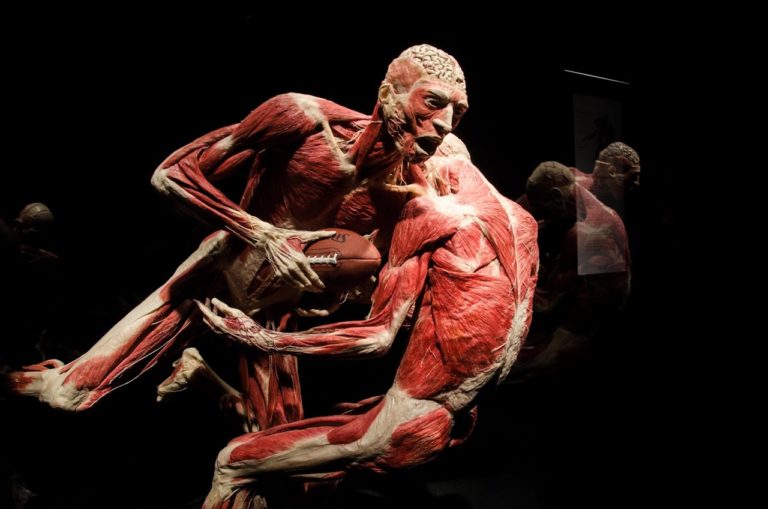
Los Angeles has long held a reputation for being body conscious.
Leadership at the California Science Center is betting – again – that proves true. The institution is bringing in the follow-up to the eerie anatomical spectacle “Body Worlds,” seeking to match or beat the record-breaking attendance that exhibit generated more than a decade ago.
The newest incarnation of the exhibit, “Body Worlds: Pulse,” will open May 20.
More than 1 million people visited the Exposition Park museum in 2004 for the U.S. premiere of “Body Worlds,” making it the best-attended special exhibition in the center’s history. It featured a 20,000-square-foot display of more than 200 human cadaver specimens treated for exhibition by German scientist Gunther von Hagens through his controversial process of “plastination,” which involves replacing body fluid with plastics.
Center President Jeffrey N. Rudolph said “Body Worlds” drew twice as many visitors a day than the center’s other top touring exhibitions, including 2015’s Dead Sea Scrolls exhibition and a Pompeii exhibition in 2014. Attendance came close to rivaling the most popular cultural exhibition in Los Angeles to date, 1978’s “Treasures of Tutankhamun” at the Los Angeles County Museum of Art, the local stop on a global touring phenomenon that logged 1.2 million visitors to LACMA over four months.
The first “Body Worlds” show, “The Anatomical Exhibition of Real Human Bodies,” which ran from July 2004 to January 2005, proved so popular that the center remained open until midnight for the last two weeks of the engagement. The run could not be extended because “Body Worlds” was headed to the Chicago Museum of Science and Industry. In order to meet demand, the Exposition Park museum quickly booked von Hagens’ “Body Worlds 2,” an equally large show with different specimens, which made its U.S. debut one week after the first exhibit closed. “Body Worlds 2” ran at the center from January to March 2005.
Ticket prices for both exhibitions ranged from and $5.75 to $12, which, if averaged out, means the center took in about $9 million in revenue.
The film “The Human Body” was also shown at the center’s theater during both exhibitions, with ticket prices ranging from $8.25 to $17.50. Tickets for “Body Worlds: Pulse” range from $13 to $20, with museum members receiving a slight discount.
Von Hagens’ show made a return five-month visit to the Science Center in 2008 with “Body Worlds 3 & The Story of the Heart.” Rudolph said that presentation drew just under 500,000 visitors, making it the second-most-successful special exhibition for the center.
Plastic matter
Rudolph declined to reveal the costs of the various exhibitions, or how the Science Center and producers of “Body Worlds” divide profits. He did note, however, that touring exhibitions often involve significant investment and risk for the center.
Rudolph said the public and media share a fascination with dead bodies, but added the museum continues its partnership with “Body Worlds” because of the educational value of the exhibitions, which have illuminated anatomy and body functions as well as the negative effects of smoking and obesity.
Prior to the 2004 exhibition, the center undertook extensive vetting to ensure that all specimens in the display, which came from von Hagens’ Institute for Plastination in Heidelberg, Germany, met ethical standards of voluntary donation.
There are more than 16,000 registered body donors to the institute, according to the Science Center, including more than 1,300 Americans, 297 of whom are from California. That number includes Rudolph, who signed up as a donor during the 2005 exhibition.
In terms of overall effect on Science Center attendance, “Body Worlds” has been beaten by the space shuttle Endeavour, which arrived at the museum with much fanfare in October 2012. Rudolph said annual attendance jumped from 1.6 million to 2.4 million after its arrival and has now stabilized at 2 million a year.
Rudolph said he expects Endeavour will be even more attractive to visitors when it moves from the center’s Samuel Oschin Endeavour Display Pavilion to its new home, the Samuel Oschin Air & Space Center. The museum has launched a $250 million fundraising campaign to construct the center. When the space shuttle reaches its new destination, Rudolph said, Endeavour, now in horizontal position, will be placed upright in launch position.
The idea of human bodies in space trumps viewing deceased specimens in a gallery, he said. “Almost everybody in our community relates to the dream of space travel.”
